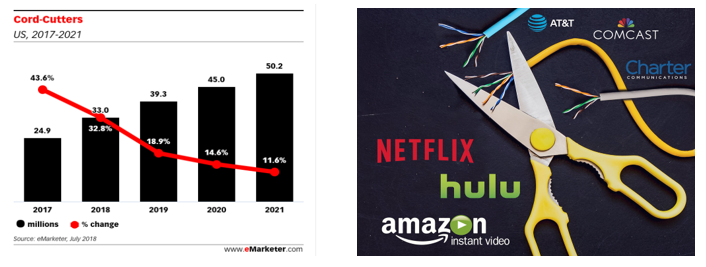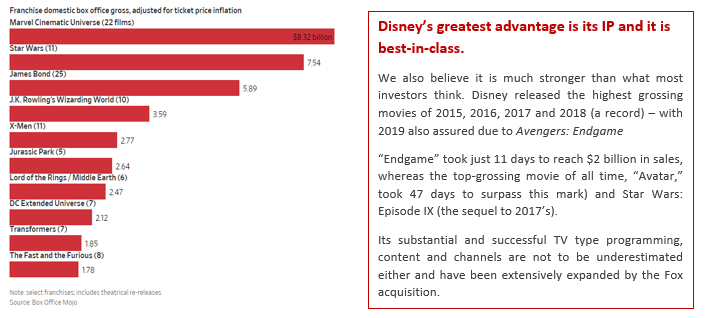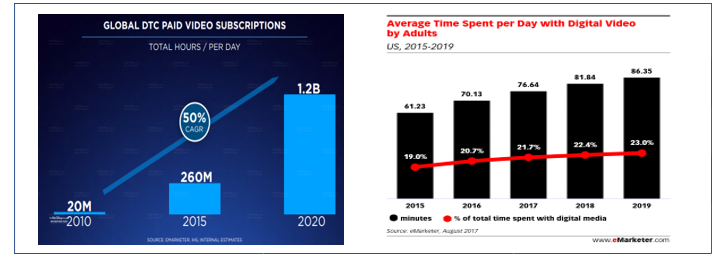Walt Disney – Content and platform powerhouse in a highly disrupted media sector
The disrupter of Pay-Tv and TV, Netflix is itself now facing a serious disruptive threat. Its rise had been extraordinary, and what many may not know, early in its development Netflix approached Blockbuster Video (remember them?) to be bought out, only to be laughed off by Blockbusters arrogant executives.
The disrupter of Pay-Tv and TV, Netflix is itself now facing a serious disruptive threat. Its rise had been extraordinary, and what many may not know, early in its development Netflix approached Blockbuster Video (remember them?) to be bought out, only to be laughed off by Blockbusters arrogant executives. 3 years later Blockbuster was no more. The disruption Netflix has created is quite extraordinary. Formidable media businesses in the United States such as Comcast, Discovery Communications, Time Warner and Viacom have been under increasing stress to cope with the pace and magnitude of the disruption its wreaked as the pace of cord-cutting accelerates. This is a global phenomenon.
This is the same pace and level of disruption that occurred to the print industry. Streaming is enabling a new level of autonomy that consumers now enjoy when choosing how, when, on what, and where they view digital video content. Pay TV is increasingly under siege as it does not deliver these features. Additionally, since many pay TV subscription packages include hundreds of channels (many of them unwanted) content discovery has become difficult for consumers.
The pace of disruption is set out below in savage reality. In the US, cord-cutting is set to double from 2017 at 24.9m households to 2021 at 50m. Again, this trend is global.
Why not Netflix – the Disruptor with an incredible 149Mn subscribers? It’s in the numbers; since 2011 whilst revenue at Netflix increased by US$12.6 billion, this is only half the total increase in expenditure. This means Netflix has burned through nearly US$13 billion of investors’ money since then. Thus, for the Netflix business model to actually work, subscriber revenue has to at least double as their new subscriber growth rates slow. How would you feel seeing your subscription go up by 100%?
Of course, they could also reduce content quality and range, but we all know what consumers do when faced with this advent from the Pay TV experience. Their structural headwinds are large. There is no doubt however that this new flexible way of viewing entertainment by in large pioneered by Netflix is here to stay and grow, but which one?
We believe the standout choice is not the one you might first jump to; Walt Disney. The entertainment giant has generated US$41 billion in cumulative free cash flow since 2011. The reverse you might say to the Netflix numbers over the same period.
Disney had 19 of the last 35 films crossing US$1Bn in the last decade; half of those from the last three years alone. Only three have cracked $2B, two again from Disney. Nine of the ten largest opening weekends in US history also belong to Disney, as does roughly 25% of the annual box office take (again, a record). It’s good at picking winners too, considering it produces just 10-12 films from over 700+ released every year. It’s has extensive distribution and pricing power as well, a crucial aspect that this industry shares with financial services.
Netflix content is strong on TV-like series, weak on movies and no sport content as any subscriber knows.
Describing Disney as a content creation powerhouse is a major understatement. This applies to series shows and movies. The key to our Disney thesis is no other company can match Disney in terms of brand value or the breadth of its content monetization channels. When one considers some of the most valuable content assets Disney owns (Pixar, Marvel, Lucas Film, ABC, Nat Geo, etc.) and their ability to aggressively monetize the success of those films and shows through theme park attractions, licensed toys, and spin-off TV series in a consistent manner. As the pace of disruption in the sector continues to accelerate, Disney is likely to be a dominant force.
Disney’s breadth and depth simply can’t fit onto this page. Hit this link to see it all. All other competitors are one big step down. https://www.cartoonbrew.com/disney/chart-every-company-that-disney-owns-172130.html
Streaming enjoys strong tailwinds. These two charts depict some of the primary factors of these long-run tailwinds for the streaming overall. Until Disney, Netflix has essentially had this sector to themselves.
Netflix is primarily also forced to use expensive junk-bonds for financing its operations and expansion, Disney has several core cash stream machines. This foray into streaming is not cheap, however. 21st Century Fox came with a $70Bn price tag (less whatever it gains for the Justice Dpt required sales of Fox regional sport networks). Thus, it’s likely that it will be circa 2023 before streaming posts profits for the Disney machine.
Disney has deep and extensive experience in broadcasting and programming across multiple forms of businesses that it will use to execute its streaming ambitions. Importantly it has learnt lessons from past mistakes and those of the industry. It is very much Future-Focused. The primary risk facing management in this strategic disruptive move is execution. It will be critical.
There are ‘pain-points’ Disney faces in this bold strategic move. An example is the likely reduction in gross revenues from licencing some of its massive IP content to some rivals. Its Pay-Tv units are facing destruction by streaming anyway, with Disney mindful of the lessons from Blockbuster and Kodak in failing to adjust to technology and consumer lead disruptors. To offset these revenue losses, gaining stepped subscriber growth at a reasonable subscription price will be essential.
Expect some clever product issuance from Disney and tactical asset disposals in this journey. For example, Disney now has a powerful Ace-card in the form of its Sports network – ESPN. Netflix has none and can’t afford to buy the only other contender even if it was for sale- Fox Sports. Disney will be seeking to win Netflix and other streaming customers over to its broader offer (think one stop shop), along with the sectors continued overall growth.
For more information on other Megatrends, please visit Insync Funds Managers’ Website here.
EQT Responsible Entity Services Limited (“EQT”) (ABN 94 101 103 011), AFSL 223271, is the Responsible Entity for the Insync Global Quality Equity Fund and the Insync Global Capital Aware Fund. EQT is a subsidiary of EQT Holdings Limited (ABN 22 607 797 615), a publicly listed company on the Australian Securities Exchange (ASX: EQT). This information has been prepared by Insync Funds Management Pty Ltd (ABN 29 125 092 677, AFSL 322891) (“Insync”), to provide you with general information only. In preparing this information, we did not take into account the investment objectives, financial situation or particular needs of any particular person. It is not intended to take the place of professional advice and you should not take action on specific issues in reliance on this information. Neither Insync, EQT nor any of its related parties, their employees or directors, provide and warranty of accuracy or reliability in relation to such information or accepts any liability to any person who relies on it. Past performance should not be taken as an indicator of future performance. You should obtain a copy of the Product Disclosure Statement before making a decision about whether to invest in this product.
*The views and opinions expressed in this article are those of the author and do not necessarily reflect the views and opinions of Reach Markets.
Reach Markets Disclaimer
Reach Markets Pty Ltd (ABN 36 145 312 232) is a Corporate Authorised Representative of Reach Financial Group Pty Ltd (ABN 17 090 611 680) who holds Australian Financial Services Licence (AFSL) 333297. Please refer to our Financial Services Guide or you can request for a copy to be sent to you, by emailing [email protected].
This publication contains general securities advice. In preparing the advice, Reach Markets Australia has not taken into account the investment objectives, financial situation and particular needs of any particular person. Before making an investment decision on the basis of this advice, you need to consider, with or without the assistance of a securities adviser, whether the advice in this publication is appropriate in light of your particular investment needs, objectives and financial situation.
Reach Markets Australia and its associates within the meaning of the Corporations Act may hold securities in the companies referred to in this publication. Reach Markets Australia does, and seeks to do, business with companies that are the subject of its research reports. Reach Markets Australia believes that the advice and information herein is accurate and reliable, but no warranties of accuracy, reliability or completeness are given (except insofar as liability under any statute cannot be excluded). No responsibility for any errors or omissions or any negligence is accepted by Reach Markets Australia or any of its directors, employees or agents. This publication must not be distributed to retail investors outside of Australia.
It is recommended that you seek independent advice and read the relevant Product Disclosure Statement before making a decision in relation to any investment. Any advice contained in this communication is general and has not taken into account the investment objectives, financial situation and particular needs of any particular person.
General Advice Warning
Any advice provided by Reach Markets including on its website and by its representatives is general advice only and does not consider your objectives, financial situation or needs, and you should consider whether it's appropriate for you. This might mean that you need to seek personal advice from a representative authorised to provide personal advice. If you are thinking about acquiring a financial product, you should consider our Financial Services Guide (FSG) including the Privacy Statement and any relevant Product Disclosure Statement or Prospectus (if one is available) to understand the features, risks and returns associated with the investment.
Please click here to read our full warning.
